Getting wasted is growing in popularity. I don’t mean drinking yourself silly and getting trashed.These days getting wasted means becoming more grounded and conscious about the food we eat and utilizing every part of it rather than throwing it out. In other words: Don’t trash your dinner.
The United States is an agricultural wonder abundant in food. Stores stock hundreds of products both farm-raised and man-made. Restaurants and food shops are on every block in cities and towns. Yet, we waste more food than we ingest, and more than 46 million Americans are living with food insecurity (lack of food). A few facts from World Food USA’s website
- Every year, consumers in industrialized countries waste almost as much food as the entire net food production of sub-Saharan Africa (222 million vs. 230 million tons)
- The amount of food lost and wasted every year is equal to more than half of the world’s annual cereals crops (2.3 billion tons in 2009/10)
- In the USA, organic waste is the second highest component of landfills, which are the largest source of methane emissions
- In the USA, 30-40% of the food supply is wasted, equaling more than 20 pounds of food per person per month
World Food Day – October 16, 2014- is a program by theBy United Nations Environment Program, Regional Office of North America.
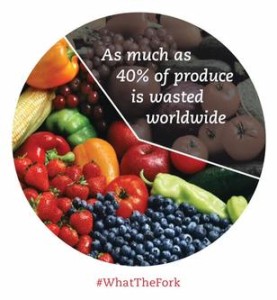
We should be aware of food waste every day and give another thought to the unused or uneaten food we toss out. Most everything is reusable in some form.Many well known chefs and food writers have written about food waste including Dan Barber and Tom Colicchio, My fave healthy restaurant chainsweetgreen haseven come up with a “Wasted Salad” in collaboration with Dan Barber. Masters Degree student Leanne Brown wrote a book, Good and Cheap: Eat Well on $4/Day which advises on ways to use food in smarter ways.
Issues of food waste have dogged me most of my life. My mother loved to shop for food but was usually too busy to cook all of it. A lot of spoiled food went into the garbage and the smells and sight of it lingered with me. As a single adult I never stocked my refrigerator; I just shopped for what I needed when I wanted it, or I dined out and took home the leftovers. These days I am even more sensitive to trimming ourfood waste and amlearning to rethink the bits and pieces of food left from our home cooking adventures.
There are dozens of ways to trim your waste. Here are six:
Do Over Left Overs:I’ve always liked to nosh on cold leftovers in the morning (e.g., pasta, salads, chicken). But what about greens that look less lively? These can be chopped and scrambled into eggs, stir fried with rice, mixed in with pasta or baked in a quiche. Leftover meats, chicken and fish can be chopped and mixed into a mixed greens or grains salad or tossed on a home-made pizza. My husband, David, always has store-bought pizza dough in the refrigerator to make a leftovers pizza for lunch.
Salad To Soup: Wilted greens and salads perk up when blended with plain yogurt or milk for a chilled soup. If you don’t like drinking dairy try using nut milk, fresh fruit juice, coconut water, vegetable broth or green or herbal tea for your liquid. A salad to soup works best when theresidual dressingis a vinaigrette. I like the added tang in the mixture.
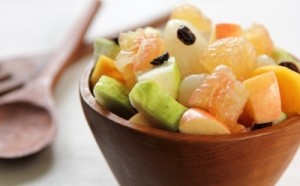
Salad today. Smoothie tomorrow (www.freedigitalphotos.net)
Just Juice It: I’ve written here about my attempts at juicing. I find it’s handy to juice vegetables and fruits that are past their peak. The flavors are still rich, and nothing goes to waste. We’re still working on recipes for the perfect cracker to take advantage of the fiber- rich residual pulp from leafy veggies like kale and spinach.
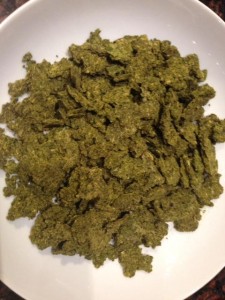
Savory Tahini Pulp Crackers
Simmer Down: Chicken stock haslong been popular for using left over bones and carcass bits. For vegetable stock, cut upthe bits, ends, stalks and skins and simmer with herbs of your choice in a pot of water just covering the vegetables for about an hour. We also reuse the vegetablebroth from pans ofsautéed greens like kale, spinach, mustard greens and Swiss chard.
Mash It: Everything tastes better folded into mashed into potatoes. We boil new potatoes and mash with Greek yogurt to taste and TBS olive oil (or butter).
Ugly Fruit = Beautiful Dishes. Imperfect or over ripe fruits and vegetables from the close out bins at supermarkets and farm stands can serve their purpose in smoothies and purées, cakes and pies, juices and vinaigrette. There is even a movement now called #uglyfruit to encourage people to not be wasteful and offer tips. www.facebook.com/UglyFruitAndVeg
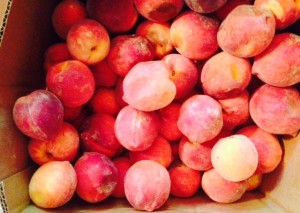
Our box of $5 farm stand peaches from Jenkin-Leukins in New Paltz, NY
There are other ways to use food waste, like creating compost for your garden. Some articles have suggested using vegetable pulp to make dog food, but Sazerac isn’t buying any of it! I enjoyed this New York Times article “That’s Not Trash, That’s Dinner” (July 27, 2011) by Julia Moskin on how growersutilizetheir waste. You can learn a lot from farmers and growers who know the economic importance of not wasting anything.
Trimming your waste makes sense economizing at home and being more sensitive to the global issues of food waste, food insecurity and the environment, Besides, it’s fun to be creative and play with your food! Now days, David and I talk trash to each other in the kitchen and make some pretty good dishes in the process!
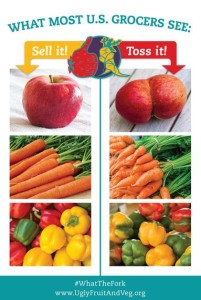
Here are some other resources I found to learn more about food waste, how to make smarter changes at home and how to be an advocate on the subject.
Please follow me on Facebook.com/FearlessFabulousMelanie and Twitter@mightymelanie and feel free to share this post.

Siamese squash anyone?
Do you have tips to trim your waste? Please share in your comments or on my facebook page.









